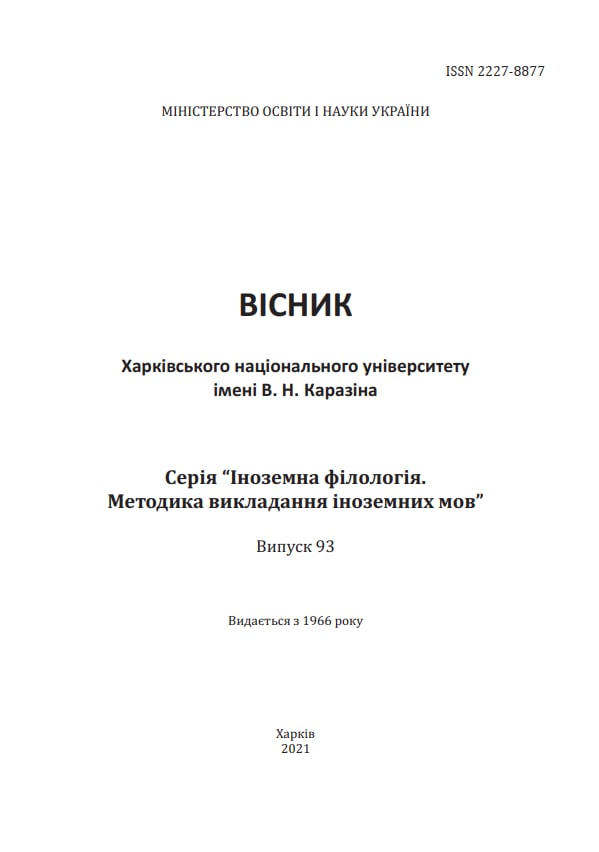Гендерні стереотипи як прояв культури в оригіналі та перекладі (на матеріалі роману-антиутопії М. Етвуд «Заповіти»)
Анотація
Статтю присвячено проблемі гендерних стереотипів, чия присутність у художньому тексті становить потужний чинник перекладацької діяльності і водночас дає можливість глибше пізнати іншу культуру, а, можливо, і свою власну. На етапі інтерпретації художнього твору перекладач повинен детально проаналізувати кожен художній образ, оскільки саме в діях персонажів, їх характері, їх мовленні знаходять вираження гендерні стереотипи суспільства, до якого вони належать. Матеріалом для дослідження слугував роман-антиутопія М. Етвуд «Заповіти». Безпосередньому вивченню підлягав образ однієї з трьох героїнь – Агнес. В образі дівчини втілюється викривлене сприйняття світу жінкою, що насаджувалося Гілеадом. Жіноче тіло вона вважає пасткою, джерелом небезпеки, відносини між чоловіком та жінкою не викликають нічого, окрім жаху та відрази. Їй заборонено вчитися читати, писати, навіть відчувати поза тим, що вважається суспільно прийнятним. Образ Агнес побудовано на основі численних художніх засобів, що досить успішно відтворюються перекладачкою. Водночас, вимальовуючи антиутопічну реальність, що має на меті застерегти від посилення гендерної дискримінації, авторка вдається до неформальних, навіть подекуди вульгарних мовних засобів, що покликані підкреслити спотвореність уявлень Агнес про власну жіночність та шлюб. Проте в українській культурі, де про гендерні проблеми не прийнято говорити настільки відкрито, де все ще панують стереотипи про те, що мова жінки не може бути грубою чи непристойною, перекладачка відчуває потребу евфемізувати такі елементи, замінюючи їх на більш стилістично нейтральні, а подекуди повністю вилучаючи. Так, ступінь усвідомленості гендерних питань, стереотипні уявлення про прийнятне та неприйнятне у мовленні та поведінці жінки визначають, яким перед цільовим читачем постане твір, створений задля привернення уваги до гендерної проблематики.
Завантаження
Посилання
Atwood, M. The Testaments. Retrieved from https://royallib.com/book/Atwood_Margaret/the_ testaments.html
Brugeilles, C., Cromer, I., & Cromer, S. (2002). Male and female characters in illustrated children's books or how children's literature contributes to the construction of gender. Population, 57(2), 237–267. Retrieved from https://www.cairn-int.info/article-E_POPU_202_0261--male-and-female-characters-in-illustrate.htm? contenu=auteurs
Denisova, I. V. (2011). Osobennosti peredachi gendernogo aspekta v perevode hudozhestvennogo proizvedenija (Avtoreferat kandydatskoi dysertatsii) [Specifics of Rendering the Gender Aspect in the Translation of a Literary Text] (Philology PhD thesis synopsis)]. Chelyabinsliy Gossudarstvennyi Pedagogicheskiy Universitet, Chelyabinsk. (in Russian)
Hofstede, G. (1984). Culture's consequences: International differences in work-related values. Beverly Hills / London: Sage.
Kirilina, A. V. (2000). Gendernye aspekty jazyka i kommunikacii (Dys. doct. filol. nauk) [Gender Aspects of Language and Communication (Philology Doct. Thesis)]. Moskovskij gosudarstvennyj lingvisticheskij universitet, Moscow. (in Russian)
Kirilina, A. V., & Tomskaya, M. V. Lingvisticheskie gendernye issledovanija [Linguistic Gender Studies]. Retrieved from http://ecsocman.hse.ru/data/2010/02/25/1208583128/OZ_2005_2_ Kirilina_Tomskaya.pdf (In Russian)
Korotayeva, A. I., & Romanova, T. V. Social'noe konstruirovanie ponjatija gender [Social Construction of Gender]. Retrieved from https://www.sgu.ru/sites/default/files/textdocsfiles /2015/03/10/korotaeva_a.i._romanova_t.v.pdf (in Russian)
Mallan, K. (2009). Gender dilemmas in children’s fiction. Basingstoke and New-York: Palgrave Macmillan.
Martyniuk, A. P. (2004). Konstruiuvannia henderu v anhlomovnomu dyskursi [Gender Construction in the English-Language Discourse]. Kharkiv: Konstanta Publ.
Nebbia, C. C. (2016). Gender stereotypes in children’s literature. Retrieved from https://scholarworks.uni.edu/cgi/viewcontent.cgi? article=1672&context=grp
Paul, L. (2005). Feminism Revisited. In P. Hunt (Ed.), Understanding children’s literature: Key essays from the second edition of “The International Companion Encyclopaedia of Children’s Literature” (рр. 114–127). London / New York: Routledge.
Pavlishak, T. A. (2014). Hudozhestvennoe proizvedenie kak reprezentant kul'tury [Literary Text as a Representation of Culture]. Vestnik TvGU. Moscow: Moskovskij gorodskoj psihologo-pedagogicheskij universitet Publ. (in Russian)
Sherry, S (1996). Gender in translation. Cultural identity and the politics of transmission. London / New-York: Routledge.
Sinkevych, O. B. Hender v identyfikatsiinykh praktykakh masovoi kultury [Gender in Identification Practices of Popular Culture]. Retrieved from https://core.ac.uk/download/pdf/268618127.pdf (in Ukrainian)
Trifonova, O. G. (2014). Gendernyj aspekt pragmatiki perevoda hudozhestvennogo proizvedenija [Gender Aspect of Pragmatics in a Literary Text Translation]. Retrieved from https://www.alba-translating.ru/ru/ru/articles/literature/trifonova2013.html (In Russian)
Woodhull, R., & Swanson, M. (2016). Look who's talking now: Representation of female characters in children's chapter books. Senior Projects Spring. Retrieved from https://digitalcommons.bard.edu/cgi/view content.cgi?article=1054&context=senproj_s2016




